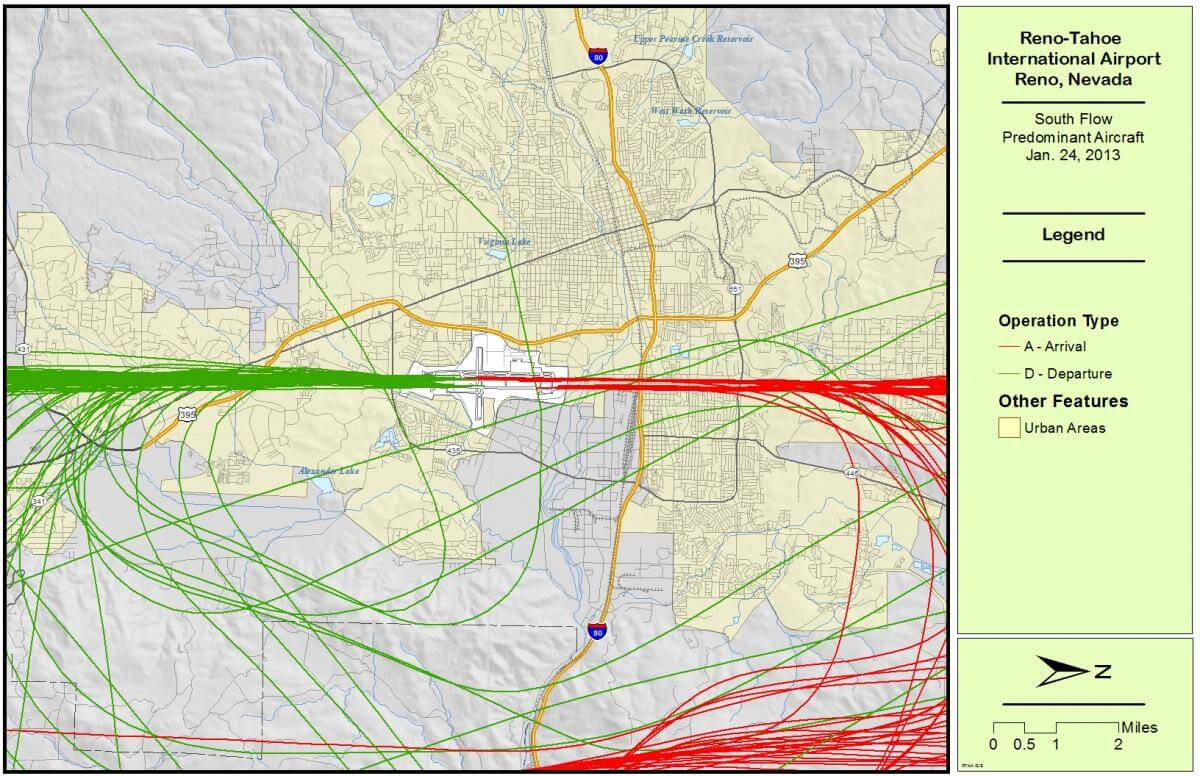Preferential Runway Use and Aircraft Overflights
The Reno-Tahoe International Airport (RNO), built in 1929, is situated at an elevation of 4,415 feet and located in the middle of a valley surrounded by mountainous terrain. Due to the geography of the area, everyone in the valley is subject to aircraft overflights. However, there are neighborhoods which will experience more aircraft overflights and potentially more aircraft noise than others. This is especially true for those who live under primary aircraft arrival and departure paths.
The following documents provide information regarding runway utilization and airport access restrictions:
- Runway Utilization Discussion Paper
- Airport Access Restrictions Discussion Paper
- Airport Access Restrictions reference pages from the updated FAR Part 150 Noise Compatibility Study

Runway Utilization
Presently, there are three runways at RNO. The two main parallel runways, generally aligned in a north-south orientation, are designated as Runways 17L/35R and 17R/35L*. There is also a crosswind runway, aligned in an east-west orientation, designated as Runway 08/26. When the airport operates in a north flow pattern, arriving and departing traffic use Runways 35L and 35R. When a south flow pattern is used, arriving and departing traffic use Runways 17R and 17L.
RNO utilizes an informal preferential runway use program that designates Runway 17R as the primary departure runway during calm and southerly wind conditions. Historically, based on an annual average, this has meant that aircraft operating out of RNO arrive and depart in a south flow configuration approximately 80% of the time and in a north flow configuration approximately 20% of the time. Runways 08/26, the east-west runways, usually account for less than 2% of the operations. They are typically used by General Aviation (GA) aircraft but, on rare occasion, are used by the larger, commercial aircraft.
Runway utilization affects the community perception of noise. Understandably, even the smallest changes in a given flight path may have an effect on the community because the operations are perceived as “different”. Although the goal is to keep arrival and departure flows as consistent and predictable as possible, aircraft performance is affected by wind direction and speed, two factors which are constantly changing. There are seasonal fluctuations, with wind patterns lasting for several weeks. However, it is not uncommon to have wind direction fluctuate several times in one day. When this happens, keeping arrival and departure flows consistent becomes more challenging, as it is best for aircraft to take off into the wind. Factors such as winds aloft, weather conditions (existing and forecasted), visibility and runway and/or taxi closures can influence runway usage. These factors, always with a safety-first focus from the pilot-in-command, will ultimately dictate where and how aircraft fly.
Aircraft Overflights
Although the Federal Aviation Administration (FAA) and airlines are currently modernizing their equipment and moving toward a greater usage of satellite based procedures**, aircraft, for the most part, are presently following set Departure Procedures (DPs), Instrument Approach Procedures (IAPs) and Standard Instrument Arrival Routes (STARs) when coming and going from airports. This includes the RTIA.
The initial segments of DPs and the final segment of IAPs are generally designed to put an aircraft in a straight path initially out of an airport on departure and into an airport on arrival. DPs are designed to facilitate the movement out of the airport area into the appropriate aircraft routes and separate them from arrivals, with minimal communication between the pilot and air traffic controller. STARs are designed to bring the aircraft into the airport area, generally to a point five (5) to ten (10) miles straight out from the appropriate runway. IAPs are designed to bring an aircraft to the airport in level flight at a constant rate of descent.
As previously mentioned, everyone in the valley is subject to aircraft overflights. However, the above mentioned Air Traffic Control (ATC) procedures result in some having more exposure than others. To view a snap-shot in time and gain a better understanding of flight tracks in the vicinity of RTIA, please click on the links below:
Figure 1: 2013 South Flow Flight Tracks of Predominant Aircraft and Figure 2: 2013 North Flow Flight Tracks of Predominant Aircraft show a sample day’s flight tracks for just the predominant aircraft in both north and south flow.


Figure 3: 2013 South Flow Flight Tracks of All Aircraft and Figure 4: 2013 North Flow Flight Tracks of All Aircraft utilize the same sample day’s flight tracks for north and south flow while showing all operations for the respective days. These days were the busiest north and south flow days of the year.


* In runway nomenclature “L” equals left and “R” equals right.
** It should be noted that these NextGen satellite landing procedures allow pilots to arrive at airports more predictably and more efficiently. This predictability means more concentration of flight tracks farther out from the airport than in years past. However, these concentrations of flight tracks have not negatively impacted the existing noise contour at RTIA.